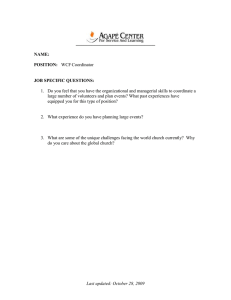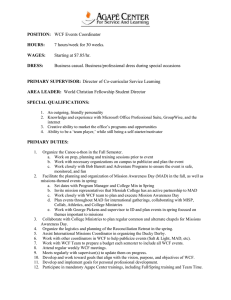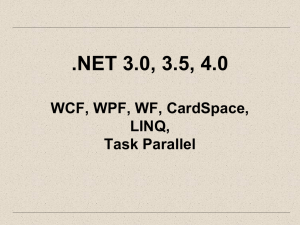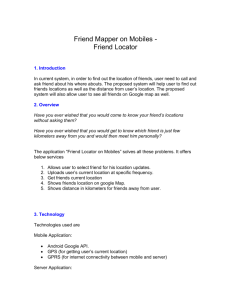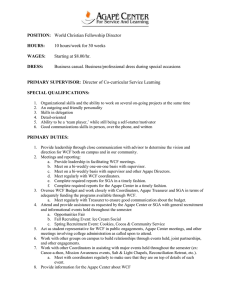IJMRA-MIE1448
advertisement
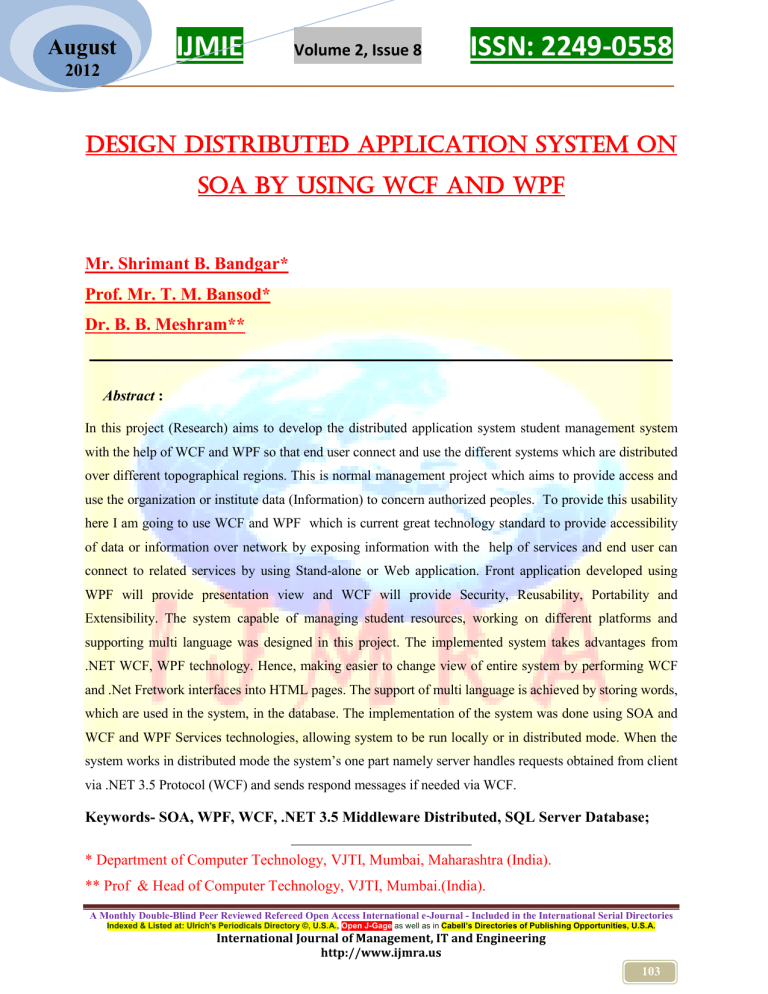
August IJMIE Volume 2, Issue 8 ISSN: 2249-0558 2012 ___________________________________________________________ Design Distributed Application System on SOA by Using WCF and WPF Mr. Shrimant B. Bandgar* Prof. Mr. T. M. Bansod* Dr. B. B. Meshram** __________________________________________________________ Abstract : In this project (Research) aims to develop the distributed application system student management system with the help of WCF and WPF so that end user connect and use the different systems which are distributed over different topographical regions. This is normal management project which aims to provide access and use the organization or institute data (Information) to concern authorized peoples. To provide this usability here I am going to use WCF and WPF which is current great technology standard to provide accessibility of data or information over network by exposing information with the help of services and end user can connect to related services by using Stand-alone or Web application. Front application developed using WPF will provide presentation view and WCF will provide Security, Reusability, Portability and Extensibility. The system capable of managing student resources, working on different platforms and supporting multi language was designed in this project. The implemented system takes advantages from .NET WCF, WPF technology. Hence, making easier to change view of entire system by performing WCF and .Net Fretwork interfaces into HTML pages. The support of multi language is achieved by storing words, which are used in the system, in the database. The implementation of the system was done using SOA and WCF and WPF Services technologies, allowing system to be run locally or in distributed mode. When the system works in distributed mode the system’s one part namely server handles requests obtained from client via .NET 3.5 Protocol (WCF) and sends respond messages if needed via WCF. Keywords- SOA, WPF, WCF, .NET 3.5 Middleware Distributed, SQL Server Database; * Department of Computer Technology, VJTI, Mumbai, Maharashtra (India). ** Prof & Head of Computer Technology, VJTI, Mumbai.(India). A Monthly Double-Blind Peer Reviewed Refereed Open Access International e-Journal - Included in the International Serial Directories Indexed & Listed at: Ulrich's Periodicals Directory ©, U.S.A., Open J-Gage as well as in Cabell’s Directories of Publishing Opportunities, U.S.A. International Journal of Management, IT and Engineering http://www.ijmra.us 103 August IJMIE Volume 2, Issue 8 ISSN: 2249-0558 2012 ___________________________________________________________ A]. INTRODUCTION Nowadays education plays a great role in development of any country. Many of education organizations try to increase education quality. One of the aspects of this improvement is managing of College resources. With growth of internet many of education organizations perform management of education resources online. However, the sites developed by those organizations support a few languages and have to be redesigned in case new languages are required to be added or interface of the entire site is required to be changed. The redesigning process takes a long time since thousand lines of code should be rewritten or modified. Taking all these disadvantages into account the system that manages College resources and supports multi languages and whose interface can be changed without rewriting all the code can be designed. To meet all requirements the system also can run on different platforms. The new technology with extendibility that technology system implements based on WCF, WPF and SOA. We know any software development need the acceptable software Architecture, User friendly User Interface View and Service which required by user. I. Service Oriented Architecture (SOA) While the Internet’s human-facing side is undergoing the Web 2.0 revolution, the machine facing side is likewise experiencing a major transformation from an application based to a serviceoriented architecture both within and across enterprise boundaries. Why is the enterprise software industry all abuzz about SOA? Enterprises have traditionally purchased new applications from a software vendor, perhaps customizing them to meet specific requirements, or developed them from scratch. Both approaches are costly in their own way and often lead to applications that are difficult to change as the organization’s needs evolve. The SOA approach does away with such monolithic applications. Instead, as Figure 1a shows, an application is structured as a set of services orchestrated by business processes. A new application is built by recomposing the enterprise’s services, including those drawn from several existing applications. If a new composite application A Monthly Double-Blind Peer Reviewed Refereed Open Access International e-Journal - Included in the International Serial Directories Indexed & Listed at: Ulrich's Periodicals Directory ©, U.S.A., Open J-Gage as well as in Cabell’s Directories of Publishing Opportunities, U.S.A. International Journal of Management, IT and Engineering http://www.ijmra.us 104 August IJMIE Volume 2, Issue 8 ISSN: 2249-0558 2012 ___________________________________________________________ requires some new services, the developer will develop and incorporate them, but it will reuse existing services as much as possible to meet the new application’s service needs. Developers can wrap legacy APIs with service interfaces and reuse them as well. They can develop new nuggets of functionality incrementally and then make them available as new services. Some of the needed services can even reside elsewhere on the Internet, hosted by software as service (SaaS) vendors. Later, as the business evolves, developers can modify corresponding processes while reusing the underlying services. The SOA approach lets enterprises repurpose software assets, thereby achieving a better return on their IT investments. It also enables a more fluid evolution of applications, making quick responses to new business needs possible. Emerging SOA tools support these objectives by making it easy to create new applications and services by composing and recomposing existing services, particularly at the business-process level. Fig. 1. Service oriented architecture. (a) Applications are supported by business processes that are themselves compositions of reusable business services. (b) Data services enable business processes to access and manipulate a SOA application’s business objects. II. Windows Presentation Foundation (WPF) A Monthly Double-Blind Peer Reviewed Refereed Open Access International e-Journal - Included in the International Serial Directories Indexed & Listed at: Ulrich's Periodicals Directory ©, U.S.A., Open J-Gage as well as in Cabell’s Directories of Publishing Opportunities, U.S.A. International Journal of Management, IT and Engineering http://www.ijmra.us 105 August IJMIE Volume 2, Issue 8 ISSN: 2249-0558 2012 ___________________________________________________________ Windows Presentation Foundation (WPF) is the graphical subsystem for all things related to the UI Windows Presentation Foundation, also known as WPF, is the next-generation graphics platform on which both Windows and web-based applications can be built to run on Windows Vista, the latest evolutionary release of the Windows operating system. WPF provides the foundation for introducing an elegant and high fidelity User Experience (UX) by juxtaposition of user interface, application logic, documents, and media content. WPF provides a number of different application models you can choose from to meet your needs. III. Windows Communication Foundation (WCF) WCF is a programming platform and runtime system for building, configuring and deploying network-distributed services. It is the latest service oriented technology; Interoperability is the fundamental characteristics of WCF. It is unified programming model provided in .Net Framework 3.0. WCF is a combined feature of Web Service, Remoting, MSMQ and COM+. WCF provides a common platform for all .NET communication(7). WCF, alongside Windows Workflow Foundation (WF) and WPF, is intended to become the primary framework for building the next wave of business applications for the Microsoft Windows operating system. WCF enables you to build powerful service-oriented systems, based on connected services and applications. You can use WCF to create new services, as well as augment and interoperate with the functionality available through many existing services created by using other technologies. When designing distributed applications in the past, you frequently had to choose a specific technology, such as Web services, COM+, Microsoft Message Queue, or .NET Framework Remoting. The Purpose of Windows Communication Foundation (3): By using Visual Studio, the .NET Framework, and WSE, you can quickly build Web services and client applications that can communicate and interoperate with Web services and client applications running on other operating systems. So why do we need WCF? Well, we already Known, Web services are just one technology that you can use to create distributed applications for Windows. Others already include Enterprise Services and .NET Framework Remoting. Another example is Microsoft Message Queue (MSMQ). If you are building a distributed A Monthly Double-Blind Peer Reviewed Refereed Open Access International e-Journal - Included in the International Serial Directories Indexed & Listed at: Ulrich's Periodicals Directory ©, U.S.A., Open J-Gage as well as in Cabell’s Directories of Publishing Opportunities, U.S.A. International Journal of Management, IT and Engineering http://www.ijmra.us 106 August IJMIE Volume 2, Issue 8 ISSN: 2249-0558 2012 ___________________________________________________________ application for Windows, which technology should you use, and how difficult would it be to switch later if you need to? The purpose of WCF is to provide a unified programming model for many of these technologies, enabling you to build applications that are as independent as possible from the underlying mechanism being used to connect services and applications together. It is actually very difficult, if not impossible, to completely divorce the programmatic structure of an application or service from its communications infrastructure, but WCF lets we come very close to achieving this aim much of the time. Additionally, using WCF enables us to maintain backwards compatibility with many of the preceding technologies. For example, a WCF client application can easily communicate with a Web service that you created by using WSE. Following fig.2(7) shows the WCF Architecture Layer, According to that way this WCF work with that Standard. Fig. 2: WCF Architecture Layer IV. SQL Server The database used to store and retrieve data of Student, Staff, Admin and Exam section. It used with the help of WCF dada Contract and Message contract. With the help of SQL server Database the data is easily available when required time. B] Design Distributed Application: Student Management system A Monthly Double-Blind Peer Reviewed Refereed Open Access International e-Journal - Included in the International Serial Directories Indexed & Listed at: Ulrich's Periodicals Directory ©, U.S.A., Open J-Gage as well as in Cabell’s Directories of Publishing Opportunities, U.S.A. International Journal of Management, IT and Engineering http://www.ijmra.us 107 IJMIE August Volume 2, Issue 8 ISSN: 2249-0558 2012 ___________________________________________________________ The WCF to describe endpoints on server providing Web services. Each of these endpoints identifies the distinct actions provided by the Web service, and the data passed to each action. In WCF, requests are directed to endpoints. The endpoints are implemented as WCF end point by address (Binding). After an endpoint receives a request, it delegates the request to the Web service's business logic, which can be also implemented as WCF Binding and contract. Fig.3 (11) shows the reply of client on WCF to identify server endpoints and services provided by server. Fig. 3: Application Architecture (WCF is used to describe endpoint of server Use Cases The Use Case diagram for the system is shown in Figure 4. As can be seen from the diagram each actor has access to different Use Case, but some of them overlap. The administrator is able to manage such resources as faculty, department, room, hour, authorities, calendar, semester, and person. It means that Administrator can add modify and delete information related to those resources. The assistant is able to view information about course, attendance, exam, grade, and schedule of course he is assists. On the other hand, in case he is given permission, he is able to create new exam and update attendance. The teacher able to view information about course, attendance, exam, grade, and schedule of course he is giving. Also he is able to update attendance, grade, and syllabus of the course he is giving and, create new exams. The student is able to view A Monthly Double-Blind Peer Reviewed Refereed Open Access International e-Journal - Included in the International Serial Directories Indexed & Listed at: Ulrich's Periodicals Directory ©, U.S.A., Open J-Gage as well as in Cabell’s Directories of Publishing Opportunities, U.S.A. International Journal of Management, IT and Engineering http://www.ijmra.us 108 August IJMIE Volume 2, Issue 8 ISSN: 2249-0558 2012 ___________________________________________________________ information about course, attendance, exam, grade, and schedule of course he is taking. Also he is able to view curriculum of own department and take courses if permission is given. Chairman is able to view information about course, attendance, exam results, grades, student details, teacher evaluation results, and curriculum of his department. Also he is able to update course, schedule and curriculum of his department. In addition he can open new course and approve students add/drop and add courses to list of courses student selected. Secretary/ Student affair is able to manage such resources as calendar, semester and person information in case permission is given by the administrator. On the other hand, he is responsible for opening and closings add/drop. Updating of evaluation results and course information can also be performed by this actor. Fig .4: Use case Diagram Client The client side class diagram is provided in Figure 5. The client side consists of WCF services that performs a request to the server side according to the parameters send from the browser either by post or get method. The response from the server is then displayed to the terminal of the user. The client side should be configured before usage. A Monthly Double-Blind Peer Reviewed Refereed Open Access International e-Journal - Included in the International Serial Directories Indexed & Listed at: Ulrich's Periodicals Directory ©, U.S.A., Open J-Gage as well as in Cabell’s Directories of Publishing Opportunities, U.S.A. International Journal of Management, IT and Engineering http://www.ijmra.us 109 August IJMIE Volume 2, Issue 8 ISSN: 2249-0558 2012 ___________________________________________________________ Fig . 5: Client Side Class Diagram Server The server side class diagram is shown in Figure 6. WCF Service class is the boundary class of server subsystem. In other words when request is obtained from the client the WCF Service class’ method is invoked. WCF Service class contains all classes responsible for generating response messages. SQL sever Database Connector class is the boundary class between server subsystem and SQL database. General Operations class consists of methods that are used by several classes. Fig.6: Server Side Class Diagram A Monthly Double-Blind Peer Reviewed Refereed Open Access International e-Journal - Included in the International Serial Directories Indexed & Listed at: Ulrich's Periodicals Directory ©, U.S.A., Open J-Gage as well as in Cabell’s Directories of Publishing Opportunities, U.S.A. International Journal of Management, IT and Engineering http://www.ijmra.us 110 August IJMIE Volume 2, Issue 8 ISSN: 2249-0558 2012 ___________________________________________________________ In this way all modules required to Student management system is Depend on each other is given below. Fig .7: Dependency between Modules C] Software Requirement Specification for project Assumptions 1 .Operational Data should be from collage system currently here I am going to use sample data. 2. This Project will go on adding different Modules as per the Requirements cleared or specified. Functional Requirements College management, Teachers and parents of student are more interested in viewing one system which should be able to provide them a consolidated view of what’s happening and how it is happing by looking through the system data, so that they could be able to take a better preventive decision. System could be able to manage college data, that should be any on formation related to Student, Staff, Management and Exam over different branches and locations where college is functional. A Monthly Double-Blind Peer Reviewed Refereed Open Access International e-Journal - Included in the International Serial Directories Indexed & Listed at: Ulrich's Periodicals Directory ©, U.S.A., Open J-Gage as well as in Cabell’s Directories of Publishing Opportunities, U.S.A. International Journal of Management, IT and Engineering http://www.ijmra.us 111 IJMIE August Volume 2, Issue 8 ISSN: 2249-0558 2012 ___________________________________________________________ Analyzing the system data at one place, a Management person acquire a better understanding of growth of college and predicts what they need to do. Like ways parents will be able to see their child’s progress by looking over the system generated reports and teachers also predicts class progress. Requirements Hardware Requirements Computer system with following minimum configuration Ram – 2 GB CPU with min 1.88gh processor Disk space – Depends on User requirements Software Requirements Windows XP service pack 2 or next operating system The .Net Framework 2.0 redistributable package(X86/X64/I64) Microsoft Windows SDK – Formerly known as Platform SDK Communications Interfaces System will communicate over internet using WCF services with Client-Server architecture model (SOA). Where client will request for something to through the specified service and then Server will respond Non-Functional Requirements Performance Performance of the system designed depends on the storage capacity, amount of data handled. A Monthly Double-Blind Peer Reviewed Refereed Open Access International e-Journal - Included in the International Serial Directories Indexed & Listed at: Ulrich's Periodicals Directory ©, U.S.A., Open J-Gage as well as in Cabell’s Directories of Publishing Opportunities, U.S.A. International Journal of Management, IT and Engineering http://www.ijmra.us 112 August IJMIE Volume 2, Issue 8 ISSN: 2249-0558 2012 ___________________________________________________________ Scalability System is capable of handling any future enhancements, other departments could be integrated to the existing system without affecting the current performance. Security To provide a secure environment, access should be provided to limit Profiles. Safety Providing only read access to the users so that they won’t able to hassle with the data. C] Conclusion: This paper briefly introduces the SOA, WPF and WCF technologies, and describes how they are capable the developed the new application like the Student management system with the help of above technologies. WCF is Microsoft’s unified framework for building and running serviceoriented applications using managed code. It enables developers to build secure, reliable, transacted solutions that integrate across platforms and interoperate with existing investments. In this way we can say that we can develop the Distributed application system based on SOA, WPF and WCF works well in using of the existing enterprise network and computer resources and available technologies, reducing the user's computer hardware requirements, scalability and compatibility. In addition, the client and host service program is a loosely coupled relationship. When demands change, the application system only needs to change the separated service program or client. A Monthly Double-Blind Peer Reviewed Refereed Open Access International e-Journal - Included in the International Serial Directories Indexed & Listed at: Ulrich's Periodicals Directory ©, U.S.A., Open J-Gage as well as in Cabell’s Directories of Publishing Opportunities, U.S.A. International Journal of Management, IT and Engineering http://www.ijmra.us 113 August IJMIE Volume 2, Issue 8 ISSN: 2249-0558 2012 ___________________________________________________________ D] References: 1) Yan Liu and Simon Truong and Shiping Chen and Liming Zhu by Composing Adaptive Web Services on COTS Middleware 2) Haitao Du, Bo Zhang , Dingfang Chen by Design and Actualization of SOA based Data Mining System 3) E.Anupriya and N.Ch.S.N.Iyengar by Dynamic Composition of Peer-to-Peer Web Service Using WCF 4) Zhao Chengping , Ning Qian and Liang Chuan Research and Design of Distributed Sluice Group Joint Dispatch System Based on WCF and OPC Technology 5) Simon S.Y. Shim, CTO, MarkAny Inc., Seoul, Korea; “web technology”. 6) Chris Andrade, Shawn Livermore, Mike Meyers, and Scott Van Vliet by “Professional WPF Programming: .NET Development with the Windows Presentation Foundation”. 7) John Sharp by Microsoft Windows communication foundation Step by Step 8) Well Logging, http://en.wikipedia.org/wiki/Welllogging 9) MSDN WCF, http://msdn.microsoft.com/-zhcn/library/ms735119.aspx 10) Kenn Scribnar by Microsoft Windows Workflows Foundation Step By Step 11) SCHOOL MANAGEMENT SYSTEM By Sonmez Serkan Sogit and Maxim Shylov A Monthly Double-Blind Peer Reviewed Refereed Open Access International e-Journal - Included in the International Serial Directories Indexed & Listed at: Ulrich's Periodicals Directory ©, U.S.A., Open J-Gage as well as in Cabell’s Directories of Publishing Opportunities, U.S.A. International Journal of Management, IT and Engineering http://www.ijmra.us 114
